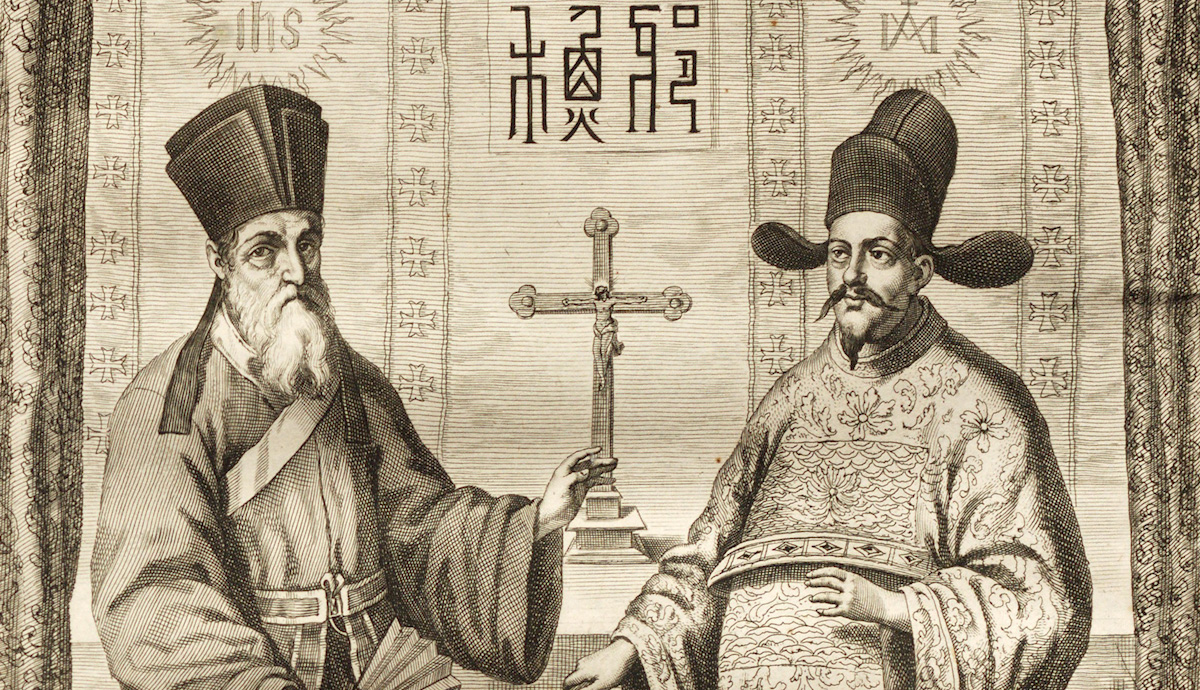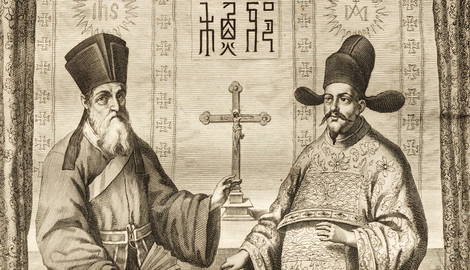
The arrival of the Society of Jesus (the Jesuits) to China in the sixteenth century would alter the trajectory of Chinese-European relations for centuries to come. While the Europeans and the Chinese had forged connections in previous historical eras, the Jesuit missions took these links to the next level. The faith of Jesus Christ and the Way of Confucius would come into dialogue like never before.
Countless actors played a role in the Jesuits’ Chinese endeavors. Local converts, European missionaries, popes, and emperors all sought to exert their agency in a changing cultural landscape. Religious conflict arose not only between the Chinese Confucian and European Catholic traditions but also within the Catholic Church itself. The Jesuits’ foray into Chinese territory would ultimately mark the last major instance of religious dialogue between China and Europe until the nineteenth century.
Christianity in China Before the Jesuits

The pre-Jesuit history of Christianity in China is fragmented. The ancient Romans had some links to their Han Chinese contemporaries, but these seem to have been largely commercial in nature. The vast distance between the two empires, as well as the existence of large states in Persia and India, may have contributed to the indirect nature of this trade.
The nine-foot-tall Xi’an Stele, a monument from the Silk Road city of Xi’an, is the first solid archaeological evidence of a Christian presence in China. This monument dates back to the year 781 and recounts Chinese Christian history up to that point. The text claims that Syriac Christian missionaries first reached the imperial capital under the Tang dynasty. Notably, the stele claims the first Christians in China originally came from Daqin — the Chinese name for Rome’s eastern provinces.

Unfortunately for China’s Assyrian Christians, their faith would not last for very long. In the mid-ninth century, Emperor Wuzong sought to purge China of foreign religions. Motivated in part by Confucian ideology, the emperor cracked down on Buddhists and Christians alike. The Assyrian Church gradually vanished, and the Xi’an Stele was buried and forgotten. Christians would return to China during the Mongol-led Yuan dynasty centuries later, most notable among them being Marco Polo. However, they were forced out again when the Han Chinese Ming dynasty was established in 1368.
Religion and Philosophy in Pre-Jesuit Imperial China

The teachings of the ancient sage Confucius have dominated Chinese religion and philosophy for over two thousand years. At times, different dynasties favored other intellectual traditions, such as Daoism and Buddhism, but Confucian thought and conduct always persisted. If anything, it usually overlapped seamlessly with Daoist and Buddhist practices.
Notions of religious identity in imperial China were almost the complete opposite of those in Christian Europe. In Europe, the Catholic Church demanded exclusive adherence. Nobody could belong to more than one religion at a time. In China, religious belief was far less delineated. Daoist, Confucian, and Chinese Buddhist teachings gradually came to complement each other or merge together. A person could read the relatively secular Confucian classics while also providing prayers and offerings for their ancestors. The Abrahamic concept of monotheistic exclusivism was unheard of to the Chinese.

If we had to choose one Chinese intellectual framework over the others, though, Confucianism would probably be the most important. Much of early Confucian philosophy was rooted in statecraft; Confucius himself attempted to advise the Duke of Lu, one of ancient China’s many warring statelets. Perhaps because of China’s tumultuous political landscape at the time, Confucius and his followers valued social stability above all else. Successive dynasties adopted Confucian theories of statecraft to varying degrees. Yet the desire for social stability always prevailed.
Importantly, Confucianism (and other Chinese belief systems) lacked the Western concept of prophethood. In the Analects — a compilation of Confucius’ teachings written down by his students — the great sage denied that he taught anything new. Instead, he argued, he was just reaffirming age-old truths. These included the obligations of relationships (ruler to ruled, parents to children, etc.) and the ritualistic cultivation of knowledge and humanity. The Confucian emphasis on self-reflection served as the foundation for the imperial educational system. Confucian thought and practices greatly influenced how the earliest Jesuits would interact with the Chinese population.
Matteo Ricci and the Early Jesuit Missions

The first Jesuits to arrive in China did so at the same time European powers were conquering and colonizing the Americas. Yet the missionaries’ experience in China would differ fundamentally from those who preached overseas. In Ming China, Europeans came face to face with a culture as literate and structured as their own. They couldn’t hope to conquer their way to supremacy, as they had with many Mesoamerican societies.
The Jesuits’ initial attempt to reach China occurred not long after their order’s founding in 1540. Saint Francis Xavier set sail in 1552, but he died before he could reach the Chinese mainland. It would be almost thirty more years before the Jesuits’ next major attempt to prostelytize among the Chinese. In July 1579, the Italian Father Michele Ruggieri settled in the Portuguese port of Macau. Three years later, another Italian priest, Matteo Ricci, would join him. They would go on to become the quintessential Jesuit missionaries during the late Ming era.
The Jesuits’ Methods: Accommodating Chinese Culture

Ruggieri, Ricci, and other Jesuit missionaries adopted a policy of accommodation toward Chinese culture. They sought to learn the Chinese language and dressed like members of the Chinese scholar-bureaucrat elite. As long as Chinese practices didn’t outright contradict the Christian message, the Jesuits tended to leave their Chinese hosts to their own devices.
Crucial to the Jesuit missions was the dissemination of European technology and scientific knowledge. Science was perhaps the most powerful weapon in the Jesuits’ intellectual arsenal — even more so than religion! Chinese elites loved their guests’ mathematical work and astronomical predictions. European and Chinese collaborators translated works such as Euclid’s Elements into Mandarin Chinese. After 1601, Matteo Ricci was even allowed to meet the Wanli Emperor — a nearly impossible feat in China at the time. Relations with the authorities would fluctuate depending on which emperor was in charge, but it seems the Chinese elite welcomed the Jesuits’ technological skills.
What Did the Chinese Think of Catholicism?

If the Chinese elites were so receptive to the Jesuits’ scientific knowledge, how did they react to their Catholicism? What about ordinary Chinese people? While government officials definitely liked their European guests’ technological skills, they were also suspicious of their proselytizing efforts. Successive emperors worried that the missionaries were proxy figures for ambitious European colonial projects. Given the Jesuits’ strong backing by the Portuguese monarchy, this was perhaps not entirely unfounded.
While Chinese imperial governments tread carefully regarding the Jesuits, many Chinese people did convert to the Catholic faith. One of the most prominent Chinese Catholic converts was the scholar-bureaucrat Xu Guangqi. Xu was a crucial collaborator with Matteo Ricci; the two men worked to translate European mathematical texts into the Chinese language. Upon his conversion and baptism, he chose the Catholic name Paul. Other notable Chinese Catholics included Blasius Liu Yunde, who became a local priest in Fujian province in 1688. Conversion rates varied across the provinces, but at least some Chinese were receptive to the Catholic message.
Geopolitics and Religion: The Dominicans and Franciscans Arrive

With the rise of the Qing dynasty in 1644, the Jesuits would work to regain imperial favor and grow their number of converts. One Jesuit, the German priest Johann Adam Schall von Bell, became head of Beijing’s imperial observatory in 1645. The situation would become more complicated, however, with the arrival of other Catholic religious orders. The Jesuits’ monopoly on Church relations with China was now under threat.
The Jesuits’ more accommodating stance towards Chinese religion and culture angered the Spanish-backed Dominican and Franciscan orders. These societies had led missionary efforts in the Americas; their approach there had been far less forgiving towards non-Christian spirituality and rituals. They saw the Jesuits’ adoption of Chinese dress and customs as blasphemous. The disagreement among the religious orders would become known as the Chinese Rites Controversy, occupying the Vatican’s time well into the eighteenth century.
The Chinese Rites Controversy and Intra-Catholic Fighting

The Chinese Rites Controversy is a challenging conflict to define. It covered multiple dimensions: language, religious ritual, and geopolitics. Essentially, it was a struggle that resulted from the meeting of divergent cultures.
When the Dominicans and Franciscans observed their Jesuit rivals’ missionary tactics, they alerted the Pope over what they viewed as superstitious indulgences. Some of their specific complaints involved the Jesuits’ adoption of Chinese words like Tian and Shangdi (both words referring to a higher existence). Additional criticism was directed toward Chinese Catholics’ continued veneration of their ancestors at family shrines.
The controversy’s presiding Popes went back and forth between support for the Jesuits and opposition. The same could be said of China’s emperors. In a 1692 decree, the Kangxi Emperor was sympathetic to the Jesuits, claiming they weren’t causing any social disturbances. He framed the Christian God as Tianzhu, a Chinese term meaning “Lord of Heaven.” For the time being, the Jesuits seemed secure.

By 1715, however, the tide had firmly turned against the Jesuits. Pope Clement XI issued an edict prohibiting Chinese converts from keeping ancestral shrines or observing Confucian holidays. Other customs, he stated, could be allowed if they did not contradict Church teachings. The Kangxi Emperor changed his tune in response. He now described the European missionaries as disruptive rabble-rousers, regardless of their religious order. Kangxi’s successor, the Yongzheng Emperor, started to persecute proselytizers after 1724. The Jesuits’ Chinese mission was running into a twofold obstacle that would ultimately sink it.
The Catholic Church declared the Rites Controversy over in 1742. Pope Benedict XIV closed all debate about the matter, and Catholic missions in China faded away. Thirty years later, Rome would disband the Society of Jesus, following the example of leading European kingdoms. Chinese Christian communities would be cut off from new preachers for the next century or even longer.
The Jesuits’ Legacy and the Future of Europe-China Relations

The Rites Controversy and the Chinese emperor’s response were the final straws for the Jesuits’ mission. As had previously happened in Japan, the Jesuits had fallen out of favor with their hosts. Rome’s abolition of the Society of Jesus would prove temporary, but it did indicate the Jesuits’ precarious religious and political position.
When the Jesuits returned to China in the late nineteenth century, the power dynamics in East Asia had fundamentally shifted. Japan was on the rise, and Europe had outclassed China in the disastrous Opium Wars. Without strong benefactors, the Jesuit missions faded away. Other Catholic organizations — as well as English-speaking Protestant missionaries — would take their place. Their anthropological efforts may have been impressive, but the Jesuits ultimately fell victim to the political struggles of a changing, interconnected world.










